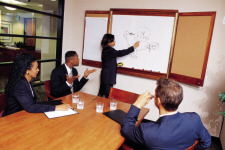![]()
1. The overhead projector (OHP) displays
overhead transparencies (OHTs). It has several advantages over the
35mm slide projector:
 • it can be used in daylight • you can face the audience • you can write or draw directly on the transparency during your presentation. 2. The whiteboard is a useful device for writing spontaneously. For prepared material, the OHP or computer-based presentation might be more suitable. 3. The board rubber (UK) or eraser (US) is used for cleaning the whiteboard. 4. Markers are used for writing on the whiteboard or the flipchart. They can be delible - you can remove the ink (whiteboard), or indelible - you cannot remove the ink (flipchart). It's a good idea to take markers with you in case you are given some used ones which do not write well. 5. The flipchart consists of several large sheets of paper that you 'flip' or turn over. Some people prefer the flipchart to the whiteboard, but its use is limited to smaller presentations. 6. The Slide projector - which must be used in a darkened room - adds a certain drama. Some slide projectors can be synchronised with audio for audio-visual (AV) presentations. These projectors are typically used for larger presentations. The majority take 35mm slides or transparencies, but projectors for 6x6cm slides are also available. 7. Transparencies are projected by an overhead projector or a slide projector onto a screen - in this case a folding screen which can be packed up and transported. 8. The notebook computer is increasingly being used for presentations together with software such as Microsoft Powerpoint. It is often used together with an overhead projector, which projects the image from the computer screen onto the wall screen. 9. Handouts are any documents or samples that you 'hand out' or distribute to your audience. Note that it is not usually a good idea to distribute handouts before your presentation. The audience will read the handouts instead of listening to you. |